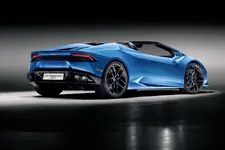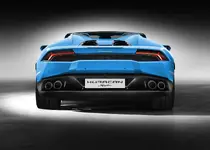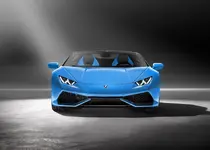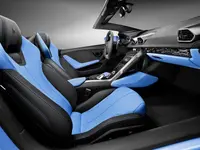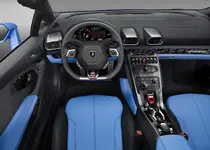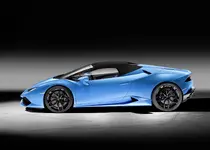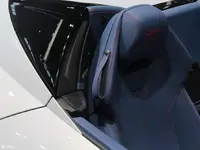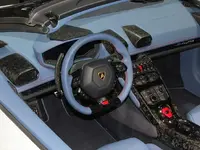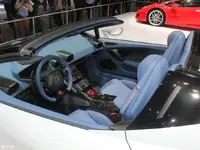You are using an out of date browser. It may not display this or other websites correctly.
You should upgrade or use an alternative browser.
You should upgrade or use an alternative browser.
Huracán [2014-2024] [Official] Lamborghini Huracan LP 610-4 Spyder
- Thread starter Merc1
- Start date
The Lamborghini Huracán is a sports car manufactured by Italian automotive manufacturer Lamborghini replacing the previous V10 offering, the Gallardo. The Huracán was revealed online in December 2013, making its worldwide debut at the 2014 Geneva Auto Show and was released in the market in the second quarter of 2014.
JHF
Driving Dynamics Pro
Lamborghini Huracan LP610-4 Spyder (2016) review

If there’s one thing that sets the Lamborghini Huracan aside from its obvious Maranello and Woking rivals, it’s the engine. Where the Ferrari 488has followed the McLaren 650S down the self-righteous path towards downsized, turbocharged enlightenment, Lamborghini has stuck to its naturally aspirated 5.2-litre V10.
The beauty of this is that you get instant throttle response and sweet, sweet linearity all the way to an 8500rpm redline – and none of the exhaust note corruption that causes such consternation when turbines start interfering with exiting gases. And the beauty of the Huracan Spyder is that you get to hear its 602 horses sing all the more clearly. Well, that and it looks bloody tremendous.
The Lamborghini Huracan Spyder sounds good then?
Oh hell yes. From the bassy, insistent idle all the way through the gargling, trumpeting mid-range to the shriek at the top, this is extrovert automotive expression that demands and deserves to be savoured.
After all, who knows how long this kind of wanton indulgence is going to last in the face of increasingly stringent emissions and economy requirements? Even with stop-start and cylinder deactivation that switches off the fuel and ignition of one entire bank of the V10, the Huracan Spyder still only manages a claimed 22.9mpg; if you’re looking for a supercar that gives a damn about appeasing your social conscience, this isn’t it.
Since you’re already beyond the point of redemption you might as well flip the ‘Anima’ drive mode selection switch on the steering wheel out of Strada and into Sport or Corsa. This makes the exhaust even louder and adds a percussive thunderclap of pops and bangs to every downshift and lift of the throttle.
Whenever the optional magnetorheological suspension is fitted, Sport and Corsa mode also stiffen the damping to the point of severe posterior discomfort on bumpy roads. That's just one of the compromises Huracan Spyder owners will have to endure in exchange for the car’s persuasive drama, however.
What do you mean, ‘compromises’?
You’re going to struggle to find anyone who won’t agree that the Huracan Spyder is a stunning piece of automotive visual theatre. While the Ferrariand McLaren might be technically impressive from an aerodynamic perspective, the Huracan Spyder is actually gorgeous – and more so than its coupe equivalent. This last is largely down to the double buttress rear deck treatment, which adds a languorous allure to the Lamborghini’s backside, like artfully draped silk.
But in order to achieve this in combination with the soft-top roof,Lamborghini hasn’t just engineered a simple, single-piece deck lid. When the roof folds down the area immediately aft of the cabin is extended by a pair of hitherto hidden fins – the parts finished in the darker colour.
The addition of the soft-top and its complex associated mechanisms adds 100kg to the coupe’s kerbweight; the 488 and 650S equivalents gain less than half that, in spite of their folding metal rather than fabric roof construction. Then there’s the impact on the interior...
What’s up with the interior?
The Spyder might offer infinite head room when the sun is shining but as soon as you get in you can’t shake the feeling that it’s a little more cramped in the two-seater cockpit than it used to be. This is in fact even more obvious from the passenger side, as there’s not only a protrusion into the footwell from the external side of the car but the footwell itself seems surprisingly shallow as well. So much so that it took Lamborghini head of R&D Maurizio Reggiani to convince us that this was a facet unchanged from the coupe.
The issue is instead one of seat travel. A new internal bulkhead and the need to avoid the seatbacks rubbing on this to prevent squeaking means the seats don’t go as far back as they used to. Not too much of an issue if you’re under six-foot and like an upright driving position but if you’re much taller, or prefer laid back gangster-lean ergonomics, this is going to be troubling.
On top of which, over-the-shoulder rear visibility is essentially nil thanks to the height of those sexy buttresses. It’s like driving a van in this respect: you have to rely almost entirely on the side mirrors.
Ah, the driving – you haven’t mentioned much about that yet…
That’s partly because Lamborghini once again chose Miami Beach as the launch location for a Spyder. This is great when it comes to understanding these cars from the perspective of how most of them are going to be driven – slowly, in high-density urban areas populated by trendy, materialistically susceptible types – and for proving that even when such areas are utterly awash with supercars, a Lamborghini has the power to attract them. But in terms of really getting to dynamic grips with this Huracan, city streets laid out in a grid pattern and subject to a maximum posted speed limit of 55mph aren’t exactly ideal.
However, since we are professionals, and we did have a Huracan coupe long-termer for several months last year, we do have a number of observations. Perhaps most importantly, chopping out a great big piece of seemingly structural metal – namely, the roof – hasn’t really done the Huracan a significant disservice.
Even over some particularly nasty Floridian surfaces, the Spyder is a remarkably rigid convertible, and though you’d struggle to call the suspension genuinely supple it is unflinchingly composed. Which is useful in a car that is claimed to do 0-62mph in 3.4sec, and has the all-wheel-drive hardware necessary to consistently – and instantly – confirm that.
The seriousness of the Huracan’s performance is never in doubt. That engine truly is mighty and being surrounded by a phalanx of turbocharged alternatives only serves to prove what a beautiful, beautiful thing big capacity natural aspiration really is. Which in turn makes whatever recalibration Lamborghini has done to improve the optional ‘Dynamic Steering’ all the more celebratory; this variable rack set-up now has a reassuring weightiness that far surpasses the initially unnerving and flighty reactions of our similarly equipped long-termer. The carbon-ceramic brakes remain unflappable if occasionally grabby, and the twin-clutch seven-speed gearbox keen to please.
Wind management is also impressive. Top up, there’s a little extra treble from the rear screen seal, but the new three-layer roof construction otherwise keeps refinement to the claimed coupe levels – though that claim is probably helped by the coupe’s general uncouthness. Top down, the adjustable rear screen height, clever channels on the side of those aforementioned buttress fins and removable mesh panels serve to keep you from getting buffeted. The Huracan Spyder is a 201mph car in either configuration.
Verdict
Ultimately, the Ferrari 488 and McLaren 650S are probably the better driver’s machines. But this Lamborghini is going to sell like half-price hot cakes in Amsterdam (relatively speaking; it does cost £205k) because it blends cor-look-at-that! drama with stunning lines, stonking performance from a superbly charismatic engine and an easy-going, unintimidating driving experience – backed up by the reassurance and traction of four-wheel drive. An awesomely compelling package; just make sure you fit within the new constraints of the cabin.
http://www.carmagazine.co.uk/car-reviews/lamborghini/lamborghini-huracan-lp610-4-spyder-2016-review/
If there’s one thing that sets the Lamborghini Huracan aside from its obvious Maranello and Woking rivals, it’s the engine. Where the Ferrari 488has followed the McLaren 650S down the self-righteous path towards downsized, turbocharged enlightenment, Lamborghini has stuck to its naturally aspirated 5.2-litre V10.
The beauty of this is that you get instant throttle response and sweet, sweet linearity all the way to an 8500rpm redline – and none of the exhaust note corruption that causes such consternation when turbines start interfering with exiting gases. And the beauty of the Huracan Spyder is that you get to hear its 602 horses sing all the more clearly. Well, that and it looks bloody tremendous.
The Lamborghini Huracan Spyder sounds good then?
Oh hell yes. From the bassy, insistent idle all the way through the gargling, trumpeting mid-range to the shriek at the top, this is extrovert automotive expression that demands and deserves to be savoured.
After all, who knows how long this kind of wanton indulgence is going to last in the face of increasingly stringent emissions and economy requirements? Even with stop-start and cylinder deactivation that switches off the fuel and ignition of one entire bank of the V10, the Huracan Spyder still only manages a claimed 22.9mpg; if you’re looking for a supercar that gives a damn about appeasing your social conscience, this isn’t it.
Since you’re already beyond the point of redemption you might as well flip the ‘Anima’ drive mode selection switch on the steering wheel out of Strada and into Sport or Corsa. This makes the exhaust even louder and adds a percussive thunderclap of pops and bangs to every downshift and lift of the throttle.
Whenever the optional magnetorheological suspension is fitted, Sport and Corsa mode also stiffen the damping to the point of severe posterior discomfort on bumpy roads. That's just one of the compromises Huracan Spyder owners will have to endure in exchange for the car’s persuasive drama, however.
What do you mean, ‘compromises’?
You’re going to struggle to find anyone who won’t agree that the Huracan Spyder is a stunning piece of automotive visual theatre. While the Ferrariand McLaren might be technically impressive from an aerodynamic perspective, the Huracan Spyder is actually gorgeous – and more so than its coupe equivalent. This last is largely down to the double buttress rear deck treatment, which adds a languorous allure to the Lamborghini’s backside, like artfully draped silk.
But in order to achieve this in combination with the soft-top roof,Lamborghini hasn’t just engineered a simple, single-piece deck lid. When the roof folds down the area immediately aft of the cabin is extended by a pair of hitherto hidden fins – the parts finished in the darker colour.
The addition of the soft-top and its complex associated mechanisms adds 100kg to the coupe’s kerbweight; the 488 and 650S equivalents gain less than half that, in spite of their folding metal rather than fabric roof construction. Then there’s the impact on the interior...
What’s up with the interior?
The Spyder might offer infinite head room when the sun is shining but as soon as you get in you can’t shake the feeling that it’s a little more cramped in the two-seater cockpit than it used to be. This is in fact even more obvious from the passenger side, as there’s not only a protrusion into the footwell from the external side of the car but the footwell itself seems surprisingly shallow as well. So much so that it took Lamborghini head of R&D Maurizio Reggiani to convince us that this was a facet unchanged from the coupe.
The issue is instead one of seat travel. A new internal bulkhead and the need to avoid the seatbacks rubbing on this to prevent squeaking means the seats don’t go as far back as they used to. Not too much of an issue if you’re under six-foot and like an upright driving position but if you’re much taller, or prefer laid back gangster-lean ergonomics, this is going to be troubling.
On top of which, over-the-shoulder rear visibility is essentially nil thanks to the height of those sexy buttresses. It’s like driving a van in this respect: you have to rely almost entirely on the side mirrors.
Ah, the driving – you haven’t mentioned much about that yet…
That’s partly because Lamborghini once again chose Miami Beach as the launch location for a Spyder. This is great when it comes to understanding these cars from the perspective of how most of them are going to be driven – slowly, in high-density urban areas populated by trendy, materialistically susceptible types – and for proving that even when such areas are utterly awash with supercars, a Lamborghini has the power to attract them. But in terms of really getting to dynamic grips with this Huracan, city streets laid out in a grid pattern and subject to a maximum posted speed limit of 55mph aren’t exactly ideal.
However, since we are professionals, and we did have a Huracan coupe long-termer for several months last year, we do have a number of observations. Perhaps most importantly, chopping out a great big piece of seemingly structural metal – namely, the roof – hasn’t really done the Huracan a significant disservice.
Even over some particularly nasty Floridian surfaces, the Spyder is a remarkably rigid convertible, and though you’d struggle to call the suspension genuinely supple it is unflinchingly composed. Which is useful in a car that is claimed to do 0-62mph in 3.4sec, and has the all-wheel-drive hardware necessary to consistently – and instantly – confirm that.
The seriousness of the Huracan’s performance is never in doubt. That engine truly is mighty and being surrounded by a phalanx of turbocharged alternatives only serves to prove what a beautiful, beautiful thing big capacity natural aspiration really is. Which in turn makes whatever recalibration Lamborghini has done to improve the optional ‘Dynamic Steering’ all the more celebratory; this variable rack set-up now has a reassuring weightiness that far surpasses the initially unnerving and flighty reactions of our similarly equipped long-termer. The carbon-ceramic brakes remain unflappable if occasionally grabby, and the twin-clutch seven-speed gearbox keen to please.
Wind management is also impressive. Top up, there’s a little extra treble from the rear screen seal, but the new three-layer roof construction otherwise keeps refinement to the claimed coupe levels – though that claim is probably helped by the coupe’s general uncouthness. Top down, the adjustable rear screen height, clever channels on the side of those aforementioned buttress fins and removable mesh panels serve to keep you from getting buffeted. The Huracan Spyder is a 201mph car in either configuration.
Verdict
Ultimately, the Ferrari 488 and McLaren 650S are probably the better driver’s machines. But this Lamborghini is going to sell like half-price hot cakes in Amsterdam (relatively speaking; it does cost £205k) because it blends cor-look-at-that! drama with stunning lines, stonking performance from a superbly charismatic engine and an easy-going, unintimidating driving experience – backed up by the reassurance and traction of four-wheel drive. An awesomely compelling package; just make sure you fit within the new constraints of the cabin.
http://www.carmagazine.co.uk/car-reviews/lamborghini/lamborghini-huracan-lp610-4-spyder-2016-review/
JHF
Driving Dynamics Pro
2016 Lamborghini Huracán LP610-4 Spyder review
It's not the purist's kind of supercar, but the Huracán Spyder is exactly what

What is it?:
You can say it’s just for narcissists. Dismiss it as a boulevard cruiser while muttering about weight and torsional rigidity, if you wish. I’d even agree that there’s real merit to that age-old anti-cabriolet argument for a number of purist sports cars. But frankly, Lamborghinis suck up attention like they suck up super-unleaded, and the Huracán was made to be an open-top. I mean, with those looks? And that noise?
So here it is. Meet the Huracán LP610-4 Spyder. Of course, it has identical running gear to that of the existing coupé, so behind your ears is a throaty 5.2-litre V10, which streams its 602bhp to all four wheels via a seven-speed dual-clutch automatic gearbox.
The fabric hood goes up or down in 17 seconds, at the touch of a button and at speeds of up to 30mph, but the inevitable extra mechanical gubbins needed to lift the lid have increased weight to 1542kg – around 100kg more than the coupé.
What's it like?:
So, does it feel fat and wobbly on the road? Er, no. Not remotely. On the roads around Miami, which, granted are not best suited to testing the limits of this car, it feels strung taut. There’s barely a whiff of body flex, regardless of the size of pothole or undulation. Essentially, unless you’re blessed with regular track access, it’s unlikely that what small compromises in rigidity there are will even encroach on your consciousness. Not even a little bit.
Our car was on standard dampers, which are really effective. The car bucks and shimmies over really scruffy roads, but it never corrupts the tyre contact with the road or resorts to the wince-inducing, wooden-feeling bump absorption that some hardcore sports cars can suffer from.
What could well annoy you is the rear visibility, since the rear deck of the Huracán Spyder is so high that the rear-view mirror barely shows you the roofline of the car behind. Other niggles could be that taller drivers will want for a big more leg room, but let’s face it, by any supercar standards, and particularly by Lamborghini’s standards, this is a car you really could live with every day.
Even with the roof down, the clever aero work - which includes buttresses behind the trailing edge of the window to suck the air back across the deck rather than letting it recirculate into the cabin - keeps things civilised. Put the roof up and you can see from the silhouette of the car that the airflow will be fairly uninterrupted, and sure enough, wind noise is impressively subdued. You still get a fair amount of rumble from those fat tyres, and the exhaust echoes gently in the background, but you could live with this.
In fact, anyone driving a Huracán is going to wallow in the noise. It’s a vehicular amphitheatre - an acoustic bonanza of popping, burbling, crescendoing, ravening V10 engine noise. It’s not an exhaust note; it’s an overture, and opening the roof only lets you enjoy it more.
The powertrain is a delight to use in everyday stuff or in more spirited use. Twitch the appropriately large manual paddles and you feel instantly in charge of the gearbox, as it quick-fires up or down a gear, letting you make the most of the V10 with its joyous lack of inertia and free-revving nature.
Maybe there isn’t the detonation of gut-wrenching mid-range acceleration that you get with the turbocharged McLaren 650S or Nissan GT-R, but there is real, deep satisfaction in using the long, crescendoing rev range of this engine. And whatever you compare it with, give it everything in a Huracán and it feels savagely, hilariously fast.
But there is a niggling sense of something missing in this car. And that, unfortunately, is in the handling. For a start, and as we’ve already established in the coupé, the variable-ratio Dynamic Steering that was fitted to our car is definitely one to avoid.
On top of that, the four-wheel drive system delivers the same edge of disappointment that there isn’t a little more life to it. Sure, in virtually any normal road use, the Huracán Spyder feels easily edgy enough to satisfy the majority of supercar owners. Dull, it isn’t.
But when you get the opportunity to push harder, to find out what it can do, it starts to reveal its slightly nannying tendency to understeer earlier than you’d like - to not respond to throttle feathering with the sort of elegant, millimetre-perfect adjustability of a Ferrari 488 or a McLaren 650S.
Even with all that, the Huracán is fun. Just looking at it is fun, let alone driving it. But this is not a car that ever feels completely unfettered by the veil of electronic interference. It never shrugs and says: "You think you’re man enough? You go for it."
Should I buy one?:
This brings us right back to our original point about what this car is going to be used for – who’s going to drive it, and where, because, for a lot of people, the sense that it’s there to thrill but is a few notches more manageable than its rivals could be exactly what sells it.
That Lamborghini launched the car at Miami Beach says it all about the sort of person and lifestyle at which this car is aimed. And do you know what, we’re going to take a reality check and not look down our purist, enthusiast noses at that.
We will say that, if you are one of said purists, a Ferrari 488 or a McLaren 650S Spider will most likely serve up more of what you’re after, but the Huracán Spyder is a masterpiece in its own right; as much due to its design and acoustic artistry as for engineering prowess, but every moment in it is a riot.
Perhaps it isn't where our £205k would go, but it’s easy to bask in the Huracán’s entertainment value nevertheless. And in terms of what most of the paying punters actually want? Lamborghini got it spot on.
Lamborghini Huracán LP610-4 Spyder
Location Miami; On sale MarchPrice £205,000; Engine V10, 5204cc, petrol; Power 602bhp at 8250rpm; Torque 412lb ft at 6500rpm; Gearbox 7-spd dual-clutch automatic; Dry weight 1542kg;Top speed 201mph; 0-62mph 3.4sec; Economy 23mpg (combined);CO2/tax band 285g/km, 37%
http://www.autocar.co.uk/car-review...016-lamborghini-huracán-lp610-4-spyder-review
It's not the purist's kind of supercar, but the Huracán Spyder is exactly what
What is it?:
You can say it’s just for narcissists. Dismiss it as a boulevard cruiser while muttering about weight and torsional rigidity, if you wish. I’d even agree that there’s real merit to that age-old anti-cabriolet argument for a number of purist sports cars. But frankly, Lamborghinis suck up attention like they suck up super-unleaded, and the Huracán was made to be an open-top. I mean, with those looks? And that noise?
So here it is. Meet the Huracán LP610-4 Spyder. Of course, it has identical running gear to that of the existing coupé, so behind your ears is a throaty 5.2-litre V10, which streams its 602bhp to all four wheels via a seven-speed dual-clutch automatic gearbox.
The fabric hood goes up or down in 17 seconds, at the touch of a button and at speeds of up to 30mph, but the inevitable extra mechanical gubbins needed to lift the lid have increased weight to 1542kg – around 100kg more than the coupé.
What's it like?:
So, does it feel fat and wobbly on the road? Er, no. Not remotely. On the roads around Miami, which, granted are not best suited to testing the limits of this car, it feels strung taut. There’s barely a whiff of body flex, regardless of the size of pothole or undulation. Essentially, unless you’re blessed with regular track access, it’s unlikely that what small compromises in rigidity there are will even encroach on your consciousness. Not even a little bit.
Our car was on standard dampers, which are really effective. The car bucks and shimmies over really scruffy roads, but it never corrupts the tyre contact with the road or resorts to the wince-inducing, wooden-feeling bump absorption that some hardcore sports cars can suffer from.
What could well annoy you is the rear visibility, since the rear deck of the Huracán Spyder is so high that the rear-view mirror barely shows you the roofline of the car behind. Other niggles could be that taller drivers will want for a big more leg room, but let’s face it, by any supercar standards, and particularly by Lamborghini’s standards, this is a car you really could live with every day.
Even with the roof down, the clever aero work - which includes buttresses behind the trailing edge of the window to suck the air back across the deck rather than letting it recirculate into the cabin - keeps things civilised. Put the roof up and you can see from the silhouette of the car that the airflow will be fairly uninterrupted, and sure enough, wind noise is impressively subdued. You still get a fair amount of rumble from those fat tyres, and the exhaust echoes gently in the background, but you could live with this.
In fact, anyone driving a Huracán is going to wallow in the noise. It’s a vehicular amphitheatre - an acoustic bonanza of popping, burbling, crescendoing, ravening V10 engine noise. It’s not an exhaust note; it’s an overture, and opening the roof only lets you enjoy it more.
The powertrain is a delight to use in everyday stuff or in more spirited use. Twitch the appropriately large manual paddles and you feel instantly in charge of the gearbox, as it quick-fires up or down a gear, letting you make the most of the V10 with its joyous lack of inertia and free-revving nature.
Maybe there isn’t the detonation of gut-wrenching mid-range acceleration that you get with the turbocharged McLaren 650S or Nissan GT-R, but there is real, deep satisfaction in using the long, crescendoing rev range of this engine. And whatever you compare it with, give it everything in a Huracán and it feels savagely, hilariously fast.
But there is a niggling sense of something missing in this car. And that, unfortunately, is in the handling. For a start, and as we’ve already established in the coupé, the variable-ratio Dynamic Steering that was fitted to our car is definitely one to avoid.
On top of that, the four-wheel drive system delivers the same edge of disappointment that there isn’t a little more life to it. Sure, in virtually any normal road use, the Huracán Spyder feels easily edgy enough to satisfy the majority of supercar owners. Dull, it isn’t.
But when you get the opportunity to push harder, to find out what it can do, it starts to reveal its slightly nannying tendency to understeer earlier than you’d like - to not respond to throttle feathering with the sort of elegant, millimetre-perfect adjustability of a Ferrari 488 or a McLaren 650S.
Even with all that, the Huracán is fun. Just looking at it is fun, let alone driving it. But this is not a car that ever feels completely unfettered by the veil of electronic interference. It never shrugs and says: "You think you’re man enough? You go for it."
Should I buy one?:
This brings us right back to our original point about what this car is going to be used for – who’s going to drive it, and where, because, for a lot of people, the sense that it’s there to thrill but is a few notches more manageable than its rivals could be exactly what sells it.
That Lamborghini launched the car at Miami Beach says it all about the sort of person and lifestyle at which this car is aimed. And do you know what, we’re going to take a reality check and not look down our purist, enthusiast noses at that.
We will say that, if you are one of said purists, a Ferrari 488 or a McLaren 650S Spider will most likely serve up more of what you’re after, but the Huracán Spyder is a masterpiece in its own right; as much due to its design and acoustic artistry as for engineering prowess, but every moment in it is a riot.
Perhaps it isn't where our £205k would go, but it’s easy to bask in the Huracán’s entertainment value nevertheless. And in terms of what most of the paying punters actually want? Lamborghini got it spot on.
Lamborghini Huracán LP610-4 Spyder
Location Miami; On sale MarchPrice £205,000; Engine V10, 5204cc, petrol; Power 602bhp at 8250rpm; Torque 412lb ft at 6500rpm; Gearbox 7-spd dual-clutch automatic; Dry weight 1542kg;Top speed 201mph; 0-62mph 3.4sec; Economy 23mpg (combined);CO2/tax band 285g/km, 37%
http://www.autocar.co.uk/car-review...016-lamborghini-huracán-lp610-4-spyder-review
JHF
Driving Dynamics Pro
New Lamborghini Huracan Spyder 2016 review
The convertible Lamborghini Huracan Spyder puts you a little bit closer to that 5.2-litre V10. Which is good.

Verdict
5
Possibly the most desirable version of the Lamborghini Huracan so far, the Spyder also backs up its knee-trembling good looks with a truly impressive set of dynamic credentials. It drives as well as the coupe, and with the hood down it sounds out of this world. If ever a car was worth £205,000, this is it.
The Lamborghini Huracan is on something of a roll at the moment. Having started life with a surprisingly muffled bang, it’s matured and got better since its introduction to the world in 2013, with improved four- and two-wheel drive versions both appearing within the last six months.
And now Lamborghini has presented us with this model, the all-new Spyder complete with a brilliant folding hood mechanism, drop dead gorgeous good looks and, best of all, that same 5.2-litre V10 engine screaming away behind your head.
In Spyder guise though the noise – and therefore the drama it inevitably brings – is richer than ever. Thus, there can be few experiences on four wheels that can top what a Spyder feels like at 8,000rpm in second gear, hood down, wind in your hair, horizon seemingly on hyperspace as it rushes towards you.
But the Spyder is far more than just a Huracan that’s had its roof removed in the name of kerb appeal. Beneath the skin Lamborghini’s increasingly thorough engineers have gone to great lengths to ensure that the driving experience remains just as pure as it is in the coupe.
Strengthening has been added font and rear to make the car over 60 per cent stiffer than its predecessor, the Gallardo Spyder, while anti-roll over bars that emerge in milliseconds – but only in the event of a full roll – have also been engineered gracefully into the rear bodywork.
The result is a car that weighs some 122kg more than the coupe, true, but with 602bhp and 560nm to propel it the Spyder is still quick with a capital Q. Zero to 62mph takes 3.4sec rather than 3.2sec (big deal) while the top speed still remains on the far side of 200mph (it will do 201mph as opposed to 204mph in the coupe) and that’s with the hood up or down, says Lamborghini.
Sant Agata’s engineers also spent an inordinate amount of time perfecting the Spyder’s aerodynamics with the hood down, not merely to ensure that it goes as fast as it does but also to make it as civilised as possible on the move, again roof up or down.
Press the magic button down by the electronic handbrake and in just 17sec the three-part soft top makes its way smoothly into the rear bodywork. Yet up until at least 80mph the Spyder is still remarkably refined, with just the faintest intrusion from the wind. This is thanks to an electric rear screen designed to eradicate buffeting, plus two removable side pods that feel a bit fragile, yes, but also do a fine job of removing swirl from around passengers’ heads.
What’s more, you can raise or lower the hood on the move at up to 30mph. Clever, yes, but practical and, as I say, very good looking, hood up or hood down.
The biggest compliment it’s possible to pay Lamborghini’sengineers about the way the Spyder drives is simply to confirm what they already claim; that it drives just like the coupe. There is occasionally just the merest hint of shimmy over really nasty expansion joints, but otherwise it seems to have suffered zero compromises in the transformation. Which means it goes like a train once you’ve wound the V10 up past 4000rpm – below that it feels mildly underwhelming in terms of torque, perhaps only because what follows is so explosive. It rides surprisingly well for such a focused supercar; it handles beautifully now that they’ve dialled out the understeer for the 2016 model year examples; and it stops just as spectacularly, too, thanks in no part to its standard fit carbon ceramic brakes.
I’m still not personally convinced about the way the Huracan steers in any of its various guises, the power assistance being too strong for my tastes, but otherwise, the Spyder really does drive as good as it looks. And when a car looks as good as this…
Key specs
http://www.autoexpress.co.uk/lamborghini/huracan/94226/new-lamborghini-huracan-spyder-2016-review
The convertible Lamborghini Huracan Spyder puts you a little bit closer to that 5.2-litre V10. Which is good.
Verdict
5
Possibly the most desirable version of the Lamborghini Huracan so far, the Spyder also backs up its knee-trembling good looks with a truly impressive set of dynamic credentials. It drives as well as the coupe, and with the hood down it sounds out of this world. If ever a car was worth £205,000, this is it.
The Lamborghini Huracan is on something of a roll at the moment. Having started life with a surprisingly muffled bang, it’s matured and got better since its introduction to the world in 2013, with improved four- and two-wheel drive versions both appearing within the last six months.
And now Lamborghini has presented us with this model, the all-new Spyder complete with a brilliant folding hood mechanism, drop dead gorgeous good looks and, best of all, that same 5.2-litre V10 engine screaming away behind your head.
In Spyder guise though the noise – and therefore the drama it inevitably brings – is richer than ever. Thus, there can be few experiences on four wheels that can top what a Spyder feels like at 8,000rpm in second gear, hood down, wind in your hair, horizon seemingly on hyperspace as it rushes towards you.
But the Spyder is far more than just a Huracan that’s had its roof removed in the name of kerb appeal. Beneath the skin Lamborghini’s increasingly thorough engineers have gone to great lengths to ensure that the driving experience remains just as pure as it is in the coupe.
Strengthening has been added font and rear to make the car over 60 per cent stiffer than its predecessor, the Gallardo Spyder, while anti-roll over bars that emerge in milliseconds – but only in the event of a full roll – have also been engineered gracefully into the rear bodywork.
The result is a car that weighs some 122kg more than the coupe, true, but with 602bhp and 560nm to propel it the Spyder is still quick with a capital Q. Zero to 62mph takes 3.4sec rather than 3.2sec (big deal) while the top speed still remains on the far side of 200mph (it will do 201mph as opposed to 204mph in the coupe) and that’s with the hood up or down, says Lamborghini.
Sant Agata’s engineers also spent an inordinate amount of time perfecting the Spyder’s aerodynamics with the hood down, not merely to ensure that it goes as fast as it does but also to make it as civilised as possible on the move, again roof up or down.
Press the magic button down by the electronic handbrake and in just 17sec the three-part soft top makes its way smoothly into the rear bodywork. Yet up until at least 80mph the Spyder is still remarkably refined, with just the faintest intrusion from the wind. This is thanks to an electric rear screen designed to eradicate buffeting, plus two removable side pods that feel a bit fragile, yes, but also do a fine job of removing swirl from around passengers’ heads.
What’s more, you can raise or lower the hood on the move at up to 30mph. Clever, yes, but practical and, as I say, very good looking, hood up or hood down.
The biggest compliment it’s possible to pay Lamborghini’sengineers about the way the Spyder drives is simply to confirm what they already claim; that it drives just like the coupe. There is occasionally just the merest hint of shimmy over really nasty expansion joints, but otherwise it seems to have suffered zero compromises in the transformation. Which means it goes like a train once you’ve wound the V10 up past 4000rpm – below that it feels mildly underwhelming in terms of torque, perhaps only because what follows is so explosive. It rides surprisingly well for such a focused supercar; it handles beautifully now that they’ve dialled out the understeer for the 2016 model year examples; and it stops just as spectacularly, too, thanks in no part to its standard fit carbon ceramic brakes.
I’m still not personally convinced about the way the Huracan steers in any of its various guises, the power assistance being too strong for my tastes, but otherwise, the Spyder really does drive as good as it looks. And when a car looks as good as this…
Key specs
- Model: Lamborghini Huracan Spyder
- Price: £205,000 (est)
- Engine: 5.2-litre V10, petrol
- Transmission: 7-speed auto rear wheel-drive
- Power/torque: 602bhp/560Nm
- 0-62mph/Top Speed: 3.4s/201mph
- Economy/CO2: 23mpg/285g/km
http://www.autoexpress.co.uk/lamborghini/huracan/94226/new-lamborghini-huracan-spyder-2016-review
Similar threads
Huracán [2014-2024]
[Official] Lamborghini Huracan STO
- Replies
- 297
- Views
- 31,251
Huracán [2014-2024]
[Official] Lamborghini Huracan Evo RWD
- Replies
- 37
- Views
- 7,067
Huracán [2014-2024]
[Official] Lamborghini Huracan EVO
- Replies
- 158
- Views
- 25,235
Huracán [2014-2024]
[Official] Lamborghini Huracan LP580-2 unveiled with rear-wheel drive & 580 PS
- Replies
- 25
- Views
- 5,641
Huracán [2014-2024]
[Official] Lamborghini Huracan LP610-4
- Replies
- 421
- Views
- 87,664
Lamborghini
Automobili Lamborghini S.p.A. is an Italian manufacturer of luxury sports
cars and SUVs based in Sant'Agata Bolognese. It was founded in 1963 by Ferruccio
Lamborghini (1916-1993) to compete with Ferrari. The company is owned by the
Volkswagen Group through its subsidiary Audi.
Official website: Lamborghini
Official website: Lamborghini
Trending content
-
GERMAN CAR FORUM
German Car Forum is an online community established in 2005, designed for car enthusiasts. It is a member-driven platform and news aggregator, providing the latest information and updates on various automobile brands. -
QUICK NAVIGATION
-
USER MENU
